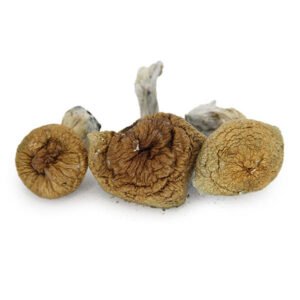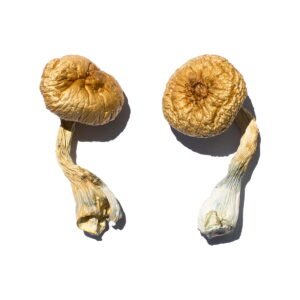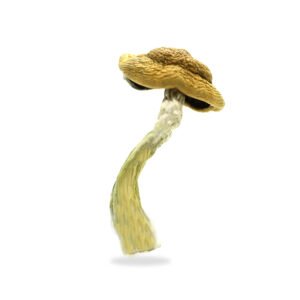Blue Meanies Mushrooms: A Definitive Guide to Panaeolus cyanescens
This species is the strongest member of the Panaeolus genus but delivers comparable potency to the average Psilocybe cubensis mushroom. Panaeolus cyanescens contains around 0.7% psilocybin and 0.1% psilocin.
Psilocybin is the prodrug for psilocin. Once inside the body, psilocybin is metabolized into the active form, psilocin. Mushrooms like blue meanies shrooms, which contain high levels of psilocybin, tend to take longer to kick in than mushrooms like Psilocybe cyanescens, which has a much higher psilocin ratio.
Addressing the Confusion Surrounding Panaeolus cyanescens (AKA “Blue Meanies”)
The many names of this mushroom have caused a lot of confusion in the past.
The proper taxonomic name of this species is Panaeolus cyanescens. “Panaeolus” comes from the Greek word meaning “all variegated” — describing the genus’ mottled or spotted texture and coloration. The species name “cyanescens” is derived from the Greek word “cyaneus,” which means blue — describing the color the mushroom’s flesh shows once bruised.
The most frequently used common name for Panaeolus cyanescens is Blue Meanies. The “Blue” part of the name comes from the color the mushroom bruises when damaged, and the “Meanies” part of the name describes their potency.
There are a few theories on where this name came from. Some believe it came from the “Blue Meanies” in the classic Beatles film “The Yellow Submarine,” and others assume that it came from the Australian slang term that has been used to describe magic mushrooms in general.
What’s confusing about this common name is the fact that other species can be described with it. In popular culture across the globe, the name “Blue Meanies” is often used to describe several varieties of psilocybin-containing mushrooms. There’s also a strain of Psilocybe cubensis known as “Blue Meanie,” further adding to the name conundrum.
Some people may also know this species by the common name “The Hawaiian,” which causes further confusion with another strain of Psilocybe cubensis called “Hawaiian.”
The Potency & Blue Meanie Mushroom Effects
blue meanie mushroom is a notoriously potent species of psychedelic mushroom — don’t be fooled by its small stature.
Many people claim that this species’ shrooms contain two to three times the amount of psilocybin than the average Psilocybe cubensis strain — though this may not be entirely correct.
In the early 1960s, Albert Hofmann — famous for being the first person to synthesize LSD (lysergic acid diethylamide) — analyzed this species, then known as Copelandia cyanescens [4]. Hofmann himself reported that these mushrooms contain far larger quantities of psilocin than psilocybin.
Psilocin is bioactive in humans, whereas psilocybin is not. The body must metabolize the psilocybin and turn it into psilocin — this is why the effects can take some time to kick in, and the peak of the psychedelic trip is “delayed.”
With higher levels of psilocin than psilocybin, fresh Panaeolus cyanescens have a faster onset of effects and a more sudden come-up.
Most studies involving blue meanie yellow submarine suggest its potency varies significantly. For example, a 1992 study by T. Stijve found Panaeolus cyanescens’ potency to be highly variable [5]. Stijve discovered that the average potency fell between 0.17 to 0.95% psilocin and 0.16 to 0.19% psilocybin (dry weight).
Based on the levels identified by T. Stijve, the average Psilocybe cubensis mushroom would likely be more potent — contrary to what many people report. In comparison, Psilocybe cubensis tends to have a psilocybin content of 0.5–1% and a psilocin content of 0.14–0.42% (dry weight).
Although P. cubensis may produce similar psilocybin levels, the species doesn’t seem capable of producing as much psilocin. This is likely why much stronger effects are reported from Panaeolus cyanescens than from Psilocybe cubensis.
What’s the Dose of Panaeolus cyanescens A.K.A Blue Meanie Mushroom
The potency of freshly harvested blue meanie mushroom is notoriously hard to gauge. It’s difficult to recommend a specific dose of these mushrooms because 1 gram from one harvest could be equivalent to 3 grams from another batch.
Most sources recommend taking a specific number of caps of blue meanies as a dose — but this is even less helpful. Not only are you faced with the intense variability of individual mushroom potency, but you’re also faced with the issue that not all mushroom caps are even the same size.
With that said, we’ve done our best to quantify the dose as much as possible here — but it’s important to keep in mind there is no hard-fast rule here. Every mushroom harvest is going to produce different experiences.
In general, if using dried mushrooms, you’ll want to go for a 20% higher dose than you would with Psilocybe cubensis. This means that for a standard 3-gram dose equivalent of Psilocybe cubensis, you should use about 3.6 grams.
If using the fresh mushrooms, you’ll need to do essentially the opposite — use about a 20% lower dose of Panaeolus cyanescens than you would with Psilocybe cubensis. This takes into account the increased psilocin levels in the fresh mushrooms.
Magic Mushroom Dosage Calculator | Blue Meanie Mushroom
Dosage guide for Psilocybe cyanescens: blue meanie dosage
- Microdose: 0.1–0.5 grams
- Standard: 1–2 grams
- Strong: 2–4 grams
- Heroic: 4+ grams
Are Blue Meanies Mushrooms Legal?
These mushrooms are illegal in most parts of the world. There are a few U.S. states (Colorado and Oregon), as well as a few local municipalities (such as Ann Arbor, Berkeley, and San Francisco, just to name a few), that have decriminalized psilocybin-containing mushrooms, however.
In Canada, psilocybin mushrooms have been decriminalized in Vancouver, British Columbia, as well as Toronto, Ontario — but they remain strictly prohibited in the rest of the country.
In several countries, such as the United Kingdom, it’s even illegal to pick mushrooms that contain psilocybin from the ground. Be careful if you decide to go in search of these shrooms in the environment surrounding your place of residence. Be sure to check the laws surrounding psilocybin in your country before going foraging for psilocybin-containing fungi.




